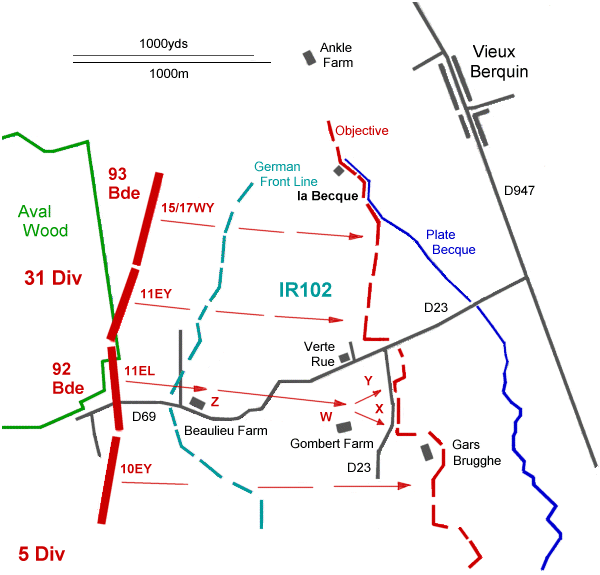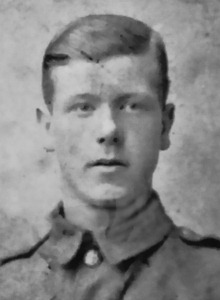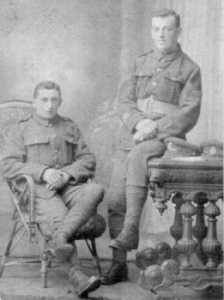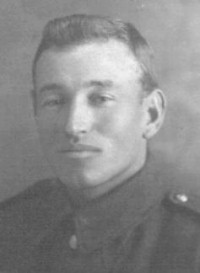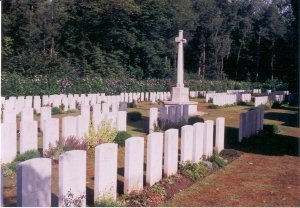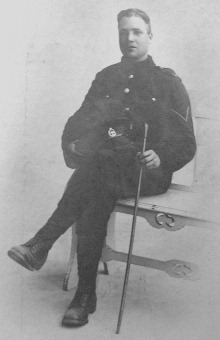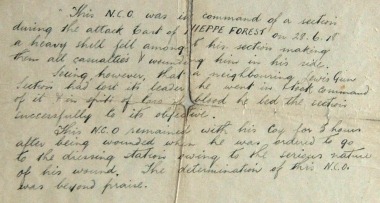
After the bitter fighting of the Battle of the Lys had ended with the failure of the German Army to break through to Hazebrouck, the front lines in the Vieux Berquin sector were re-established in front of Aval Wood, on the eastern fringe of the Nieppe Forest. On 20th June 1918, 5th and 31st Divisions received orders to attack on a 6,000-yard (5.5km) front east of the Nieppe Forest. The operation was designed both to disrupt any plans the enemy might have for a renewed offensive, and to push the British lines away from the edge of the wood where they had made an easy target for hostile artillery. In a nighttime operation aimed at securing a position from which enfilade fire could be used to support the main attack, two companies of the 13th York & Lancasters supported by part of two companies of the 18th Durham Light Infantry captured Ankle Farm in the early morning of 27th June. Later that day the main attack was practiced by 92nd Brigade (31st Division) in the area of la Papote, some 3½ miles (5-6km) behind the front line. Conditions were all too realistic. As the regimental historian wryly remarked: "The closing stages were somewhat marred through the enemy putting down a heavy destructive shoot on the imaginary final objective which gave a touch of reality to the proceedings which was neither helpful nor desired." In one of many contrasts to the opening day of the Battle of the Somme two years previously, the enemy were not to be forewarned of the attack by a preliminary artillery bombardment. The attacking troops reached their assembly trenches in the quiet early hours of the 28th, unnoticed by the enemy. At the far left of the 31st Division front, the 15th/17th West Yorkshires (Leeds Pals & Bantams) of 93rd Brigade were to capture and consolidate la Becque Farm - from which the action takes its name - before pushing on to Plate Becque stream. To the right of the West Yorkshires were the three battalions of 92nd Brigade, the 11th East Yorkshires (Hull Tradesmen), 11th East Lancashires (Accrington Pals), and 10th East Yorkshires (Hull Commercials). The two Hull battalions were each to attack in four waves, with the first two waves expected to go straight through to the final objective. The objectives allocated to the 11th East Lancashires included the capture and consolidation of two heavily-fortified farms. For this reason, the battalion was to employ a "leap frog" approach, in which "Z" Company would halt after capturing Beaulieu Farm, allowing "W" Company to pass through to capture and hold Gombert Farm; "X" and "Y" Companies would then move on to the line of the final objective. To the right of the 10th East Yorkshires, 5th Division was to attack with five battalions in line.
As an intense shrapnel barrage broke over the enemy front line at 6am on the 28th, the first wave of attacking troops left their trenches and hurried forward through the tall crops. The enemy wire was easily passed through - one battalion commander likening it more to trip wire than anything else - and the first wave was able to close up to the barrage before its first lift. On the extreme right of the 31st Division front, a few guns tragically fired short into the right forward company of the 10th East Yorkshires, Major Colin Traill M.C. being among those killed. At the moment the shrapnel barrage lifted, British troops swarmed forward giving the enemy little or no chance to reach machine guns or man parapets before being overrun. Behind the German lines, gun batteries, road junctions and likely assembly points were being targeted by heavy artillery while the main road through Vieux Berquin was cloaked by a thick smoke screen laid down by Australian artillery. On the left of the attack, the 15th/17th West Yorkshires encountered only isolated pockets of resistance in driving through to their objectives under the protection of the creeping barrage. In circumstances that were repeated along the length of the front, attacking troops pressing too closely to the barrage were inevitably hit by their own shrapnel, accounting for many of the battalion's 170 casualties. Lt.-Col. Gurney, commanding the 11th East Yorkshires, commented that while his battalion faced little resistance from enemy infantry "individual [enemy] MG teams put up splendid fights to the last, which in certain cases necessitated flanking movements". By 7.25am, both forward companies of the battalion had taken their objectives. Patrols sent out towards the Plate Becque found no enemy west of the stream. At the centre of 92nd Brigade, it was vital that Beaulieu Farm - known to be heavily garrisoned with heavy and light machine guns - was quickly captured by the 11th East Lancashires. Pressing closely behind the creeping barrage, "Z" Company led by Capt. Spencer Fleischer stormed the farm before many of the guns could be brought to bear. Fleischer personally rushed one of them. To his right, 2/Lt. Norman Fuller and L/Cpl. Wilfred White - having already overrun one machine gun in the front line - charged at another. White was killed in the attempt, Fuller going on to shoot the enemy gunner with his revolver and take the gun.
With the capture of Beaulieu Farm, "W" Company led by Capt. Cyril McKenzie moved through to press on behind the barrage to Gombert Farm. Although enemy machine guns began to exact a terrible toll as "W" Company crossed the 1,100 yards (1,000m) between the two farms, Gombert Farm was captured shortly after 7am.
As "W" Company consolidated on a line from Gombert Farm to Verte Rue, "X" and "Y" Companies led by Capt. George Bentley forged ahead to the final objective 300 yards (275m) beyond Gombert Farm. Both companies reached their objectives, though not before "X" Company had been reduced to just 34 men under the command of Sgt. Beech. Despite having been severely wounded by shellfire, C.S.M. James Fleming led two platoons of "Y" Company to their objectives after the loss of their officers. During their advance across more than 1,500 yards (1,400m) of ground, the 11th East Lancashires captured 10 light machine guns, 2 heavy machine guns, 1 heavy trench mortar, 2 medium trench mortars and 2 light field guns. The battalion suffered the heaviest casualties in 31st Division with 253 men killed, wounded or missing.
Capt. Spencer Fleischer was awarded the Distinguished Service Order. Military Crosses were awarded to Capt. George Bentley (Bar), Capt. Cyril McKenzie, 2/Lt. Norman Fuller and C.S.M. James Fleming. Sgt. Otho Elliott, Cpl. James Ashton, L/Cpl. John Foden, L/Cpl. John Ratcliffe, L/Cpl. Fred Watson and Pte. Frank Dixon were each awarded the Distinguished Conduct Medal. Military Medals were awarded to A/Sgt. Andrew Raymond Greenwood, Cpl. Russell Bradshaw, A/Cpl. Samuel Maude, L/Cpl. Percy Crabtree and Pte. Harold Bell.
At the right of the 31st Division front, the 10th East Yorkshires encountered little resistance in reaching all of their objectives by 7.20am. The enemy were found to have been occupying makeshift defences comprising little more than unconnected slit trenches with adjoining shelters, most if not all of which were not even shrapnel-proof. The battalion's advance was held up only for a short time by machine gun fire from Gars Brugghe; the farm was soon captured in an outflanking manoeuvre supported by a brief trench mortar bombardment. In the operations of 27th-28th June, 31st Division reported the capture of 278 men from I.R.102 along with 3 field guns, 10 heavy machine guns, 29 light machine guns, 4 heavy trench mortars and 5 light trench mortars. 223 of the enemy were buried in the area of the advance with more thought to be lying undiscovered in the thick crops. More of the enemy were undoubtedly killed by the barrage of artillery and machine gun fire placed beyond the line of the objective. All objectives were reached practically on time. To the right of 31st Division, 5th Division was no less successful. After the retreats of March and April, La Becque was one of the first operations in which the Allies returned to the offensive. Although no-one could have foreseen it at the time, the end of the war was less than 5 months away. The Battlefield Today Just before the D947 from Estaires reaches the village of Vieux-Berquin, turn left on to the D23 signposted to Caudescure. After a distance of 800 yards (750m), follow the road as it bends sharply left at the junction with the D69. Park around 200 yards (200m) further on. You are now on the line of the final objective of the 11th East Lancashires. The farm in the fields to the right stands on the 1918 site of Gombert Farm. Beyond it lies Aval Wood, the closest edge of which marks the starting point for the attack. Return to the junction with the D69 and turn left. Park 0.9 mile (1.5km) further on, from where a pathway leads to Aval Wood Military Cemetery. The cemetery is a most peaceful spot; 45 men of the 11th East Lancashires are known to be buried here. From Vieux Berquin it is only a short distance to the battlefield of the Lys where the 11th East Lancashires fought between 11th and 13th April 1918. Note: The 1918 site of Beaulieu Farm is 450 yards (400m) east of Aval Wood, on the D69. Nothing remains of the buildings. To confuse matters, the modern Beaulieu Farm is on the 1918 site of Gombert Farm.
© Andrew C Jackson 2000-2001 Compiled from TNA documents WO95/2343, WO95/2356, WO95/2357 and WO95/2358, "The History of the East Lancashire Regiment in the Great War" edited by Major General Sir N. Nicholson, "The History of the East Yorkshire Regiment in the Great War" by Everard Wyrall, "The West Yorkshire Regiment in the War" by Everard Wyrall, and with the kind help of Bob Ashton, David Ingham and Andrew Stevenson.
|
